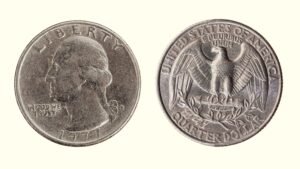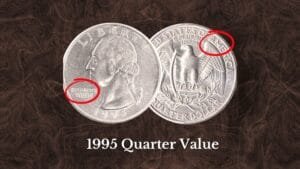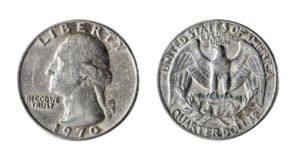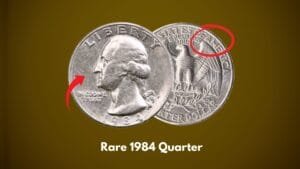If you want to know the real value of that old 1979 Washington Quarter in your coin collection, you’re at the right place! This ordinary-looking coin can fetch a stunning amount of up to $1,500 today. In this guide, you’ll learn about all the rare features and factors like grades, mint marks, and errors that can turn a regular 1979 quarter into a fortune!
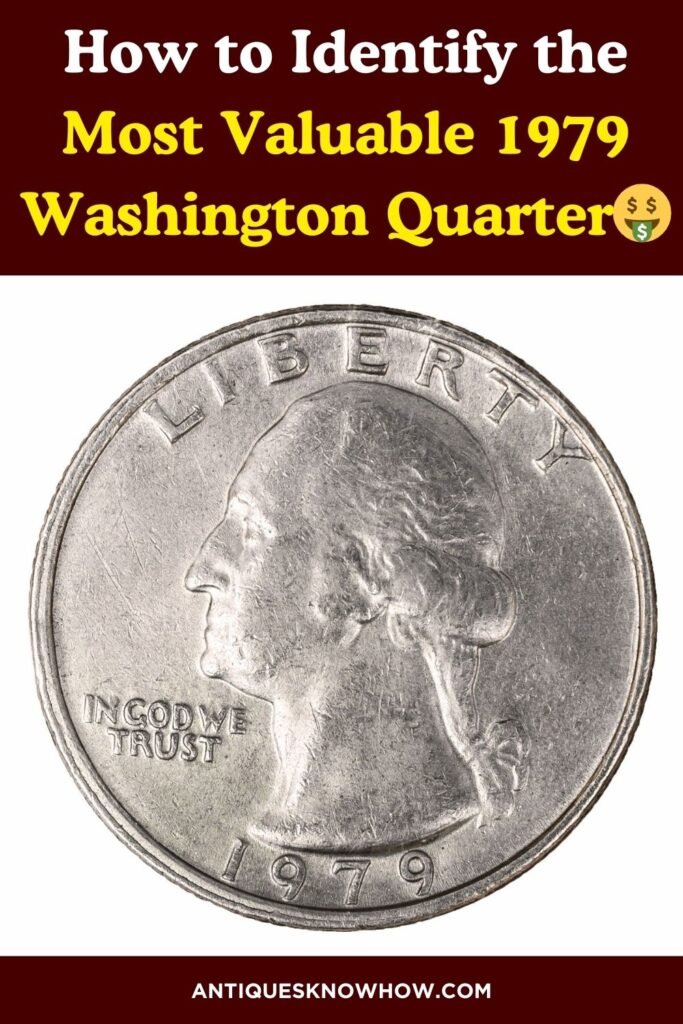
The average value of a circulated 1979 Washington quarter ranged from $0.25 to $1, while that of uncirculated coins or those with rare features and errors can fetch up to $2,500 or more.
1979 Washington Quarter History
A major part of the Washington Quarter series was first minted in 1932 to honor George Washington on his birth’s bicentennial, and the 1979 quarter features Washington’s profile on the obverse and an eagle on the reverse.
By this year, the U.S. Mint had already shifted to a Nickel-clad copper composition from the original silver composition. This year saw significant minting activity at different locations, with total production reaching over 1 billion coins.
| 1979 Washington Quarter | Key Facts |
| Coin Composition | copper-nickel-clad |
| Minting Location | Philadelphia, Denver, San Francisco |
| Year of Minting | 1979 |
| Weight | 5.67 g |
| Diameter | 24.26 mm |
| Thickness | 1.75 mm |
| Designer | John Flanagan |
| Face Value | $0.25 (25 cents) |
| Mint Marks | D – Denver Mint S – San Francisco No Mint Mark – Philadelphia |
| Total Mintage | 1,012,174,955 |
How to Identify a 1979 Quarter (Design & Physical Features)
A 1979 Washington Quarter coin’s design and composition offer valuable clues about its authenticity and potential value. Look for the following features:
1979 Washington Quarter Obverse

- A left-facing profile of George Washington
- The words “IN GOD WE TRUST” written on the lower-left
- “1979” at the bottom
- The word “LIBERTY” above Washington’s head
- “D” or “S” mint mark, if present, near Washington’s ponytail
1979 Washington Quarter Reverse
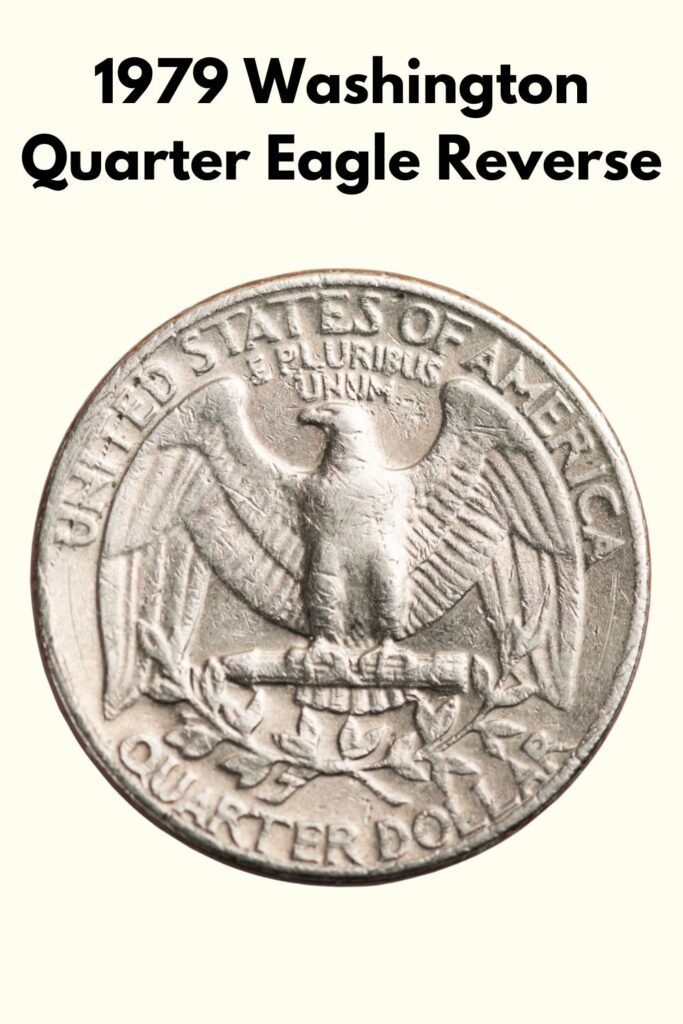
- A left-facing eagle with spread-out wings
- A bundle of arrows in eagle’s claws
- Two olive branches tied together below the eagle
- “UNITED STATES OF AMERICA” along the upper half-edge
- The US motto, “E. PLURIBUS UNUM,” in small fonts above the eagle’s head
- “QUARTER DOLLAR” on the bottom
1979 Quarter Coin Composition and Dimensions
The 1979 Washington quarter boasts a unique composition of copper-nickel clad, with an outer layer of 75% copper and 25% nickel bonded to a core of pure copper. This composition gives it a unique silvery look and a distinctive weight of around 5.67 grams.
As for its size, the clad quarter has a diameter of 24.26 mm and a thickness of 1.95 mm, making it perfectly sized for easy handling. The coin’s edge is reeded, featuring a series of uniform grooves that prevent counterfeiting and add to its aesthetic appeal!
4 Key Factors to Assess a 1979 Quarter Dollar Value
| Coin Grades | Condition Details | 1979 No Mint Mark Quarter Value | 1979 D Quarter Value |
| Poor (0) to Extremely Fine (XF45) | Significant wear, faded but visible details | 10 to 20 cents | 10 to 50 cents |
| Almost Uncirculated (AU50) to Mint State (AU58+) | Slight wear on highest points, visible marks or blemishes | 50 cents to 80 cents | 50 cents to $1 |
| Mint State (MS60 – MS64) | Uncirculated with minimal wear | $1 – $7 | $5 – $10 |
| Mint State (MS65 – MS66+) | Nearly flawless with very minor imperfections | $10 – $30 | $15 – $60+ |
| Mint State (MS67 – MS67+) | Well-preserved with no major flaws | $60 – $320+ | $110 – $450+ |
| Mint State (MS68 or Above) | Nearly perfect, luster, no major marks or flaws | Around $1,400 | N/A |
While most average 1979 quarters are worth face value or a few dollars, the value can significantly increase based on factors like mint marks, condition, and any rare errors it may possess. Let’s see how:
1. Coin Grading and Condition
The value of a 1979 Washington quarter is heavily influenced by its grade, reflecting its condition. The grades range from PO-1 to MS-70, with higher grades indicating excellent condition fetching higher prices.
For example, an MS-68 grade 1979 quarter sold for $1,440 at Heritage Auctions, while the same coin in MS-65 grade is worth only $5-$10. Lower grade examples are worth even less.
2. 1979 Washington Quarter Mint Marks & Mintage
The total mintage for the 1979 Washington Quarter across all mint locations was over 1 billion, but variations in mint marks affected the coin’s rarity and value.
1979 No Mint Mark Quarter (Mintage – 518,708,000)
The Philadelphia Mint and West Point together produced about 515 million quarters, all with no mint mark on the obverse. While a circulated 1979 P Washington quarter is worth a few cents, an MS64 grade can fetch around $5, and MS68 examples can be worth up to $1,500!
1979 D Washington Quarter (Mintage – 489,789,780)

The Denver-minted 1979 quarters are identified by the small D mint mark. Although slightly less common than no mint mark variety, the 1979 D quarter is also worth about $1 in lower grades. Higher grades like MS66 can reach around $34, with MS67+ coins fetching up to $2,250.
3. 1979 S Quarter Proof Coin (Mintage – 3,677,175)
The San Francisco Mint only produced proof quarter coins in 1979, all featuring an S mint mark on the obverse and a highly reflective proof finish.
Due to the lower mintage numbers compared to circulating coins, 1979 quarter-proof coins can be valuable, with values ranging from about $2 for lower grades to $30 or more for high-quality proofs. Some proof quarters feature a stronger contrast between the frosted design and the reflective field than regular proofs, making them rarer.
Besides, two other proof varieties are available:
- 1979 Type I Proof Quarters: This variety features a bold and filled “S” mint mark. PR70 DCAM examples of Type I proof have sold for over $400. PR-68 examples are worth around $10-$40.
- 1979 Type II Proof Quarters: This proof variety exhibits a clear and thin “S” mint mark. A PR70DCAM 1979 25C coin sold for $495 in a coin auction! PR-68 coins are around $5-$20.
4. 1979 Washington Quarter Dollar Errors
Rare mint errors can turn an ordinary quarter dollar into a prized collectible. Here are some noteworthy 1979 Washington quarter minting errors to look for:
Missing Clad Obverse
This error occurs when the outer layer of copper nickel fails to bond to the copper core on the obverse (front) side. To identify, look for a reddish-copper color on the obverse instead of the silver luster.
The value of a 1979 quarter with the missing clad layer ranges from $80 to $200 or more, depending on variety and condition. An MS64 example sold for almost $110 in a coin auction!
Double Curved Clips Error
This 1979 quarter error results from a planchet being struck twice by the blanking die, creating two curved clips on the edge. To identify, look for two smooth, curved indentations on the coin’s edge. The value depends on the size and prominence of the clips, typically ranging from $20 to $500.
A 1979 25C Washington Quarter with Double Curved Clip error in MS65 grade sold for over $510 at Heritage Auctions.
Struck Thru with a Staple
Struck-through errors happen when a foreign object gets between the die and the planchet during striking. In this case, the object is a staple. You can spot it by a staple-shaped indentation on the coin’s surface. An MS65 1979-D quarter struck through a staple and was auctioned for almost $330 in 2015!
1979 Quarter 20% Off-Centre on a 37% Clipped Planchet
This rare coin combines two errors: an off-center strike with a clipped planchet. To spot this, look for a partial design with a blank area and an irregular edge with a curved clip. Due to its rarity, this error can fetch $100 to $300 depending on grades.
Struck on Jefferson Nickel
This error occurs when a 1979 Washington quarter design is mistakenly struck on a Jefferson nickel planchet. To identify, check the weight (5.67g for a nickel vs 5.67g for a quarter) and look for a slightly smaller diameter. An XF example of this rare coin sold for $184 at Heritage Auctions. The better conditions can fetch higher values.
The 1979 Washington quarter may look like a common coin unless you understand how rare features and errors can manifold its basic value. So, before you buy or sell your quarter, use this guide to assess its best worth!
Note: This article is intended for informational, educational, and entertainment purposes only. Some images are illustrative and may not represent actual brands, products, or related entities. All trademarks, product names, brand logos, packaging, and other intellectual property referenced remain the exclusive property of their respective owners. Any brand mentions or references are provided solely for descriptive and educational context and do not imply any formal or commercial association.




